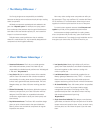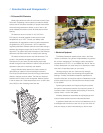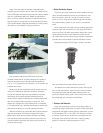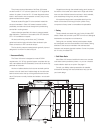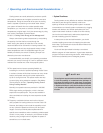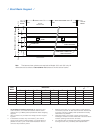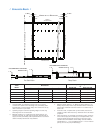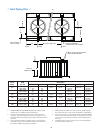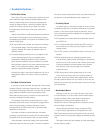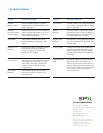11
■ Cell Partition Options
Every Class 160 tower includes plenum partitions and hot
water distribution basin partitions between adjacent cells.
Plenum partitions keep air from entering an operating cell
through an adjacent idle fan—assuring consistent thermal
performance. Basin partitions let you inspect and clean
individual basins while the rest of the tower continues to
operate.
Specify extra partitions carefully because excess partitions
can sometimes discourage routine maintenance and good
housekeeping procedures. Two options are available to meet
specic design goals:
❑ Fill area partitions are available, but usually not necessary.
The solid sheet design of lm ll prevents water and air
migration between the ll areas of adjacent cells in all
operating modes.
❑ Complete watertight partitions let you use adjacent cells
to serve separate loads having incompatible system
temperatures. Watertight partitions consist of exterior
grade, pressure-treated r plywood, sealed to cold water
basin partitions made from the same material as the basin
sides. For concrete basin partitions, Marley drawings
specify the appropriate design dimensions.
Optional weir gates in wood basin partitions let you mix or
segregate the water in the basin to meet your operating
needs.
■ Cold Water Collection Basins
If you plan to locate your tower above grade, we can supply
a treated Douglas r cold water collection basin, complete with
the necessary operating accessories. The basin oor is exterior
grade, pressure-treated r plywood, supported on joists.
Basin sides are also plywood, machined to t the basin oor,
providing a watertight joint after sealing.
The standard wood basin includes at least one or more
depressed, side-outlet sumps, complete with plugged drains
and hot dip galvanized or stainless steel debris screens.
Standard sumps are FRP construction or galvanized steel
depending on outlet size.
Each basin includes an overow/cleanout connection
consisting of a galvanized full coupling and normally-installed
standpipe which removes easily for ush-out basin cleaning.
A oat operated, mechanical makeup valve automatically
replenishes water lost from the system. The valve is located in
the plenum chamber between ll banks, just inside the endwall
access door to facilitate adjustment and maintenance.
■ Fire Safety Options
On specic jobs you may want to weigh the cost of various
modications against the cost (and maintenance) of a sprinkler
system—or the cost of higher insurance premiums. One or
more of the following tower modications may negate the need
for a sprinkler system:
❑ Fire-retardant fan cylinders offer ame spread less than 25
per ASTM E-84.
❑ A ¹⁄₄″ thick ber-reinforced cement board (FRC) overlay on
the fan deck acts as a re stop and provides a nonskid
walking surface.
❑ A ¹⁄₄″ FRC overlay on the distribution basin covers acts as a
re stop.
❑ Barrier walls keep re from spreading between cells in
multicell towers. Specify barrier wall design by containment
period, such as a “20-minute re wall”. Barrier walls consist
of pressure-treated r plywood between cells. Plywood
thickness (and cost) vary according to the specied
containment time.
❑ FRP casing having a ame spread rating of 25 or less.
If your insurance carrier insists on a sprinkler system for
your tower, consult your Marley sales representative. We can
provide a sprinkler system to t your needs, or work with your
people to be sure that the sprinkler system and tower will meet
your specication.
■ Non-Standard Motors
Although you can buy your Class 160 tower “less motor”
at a cost reduction, it is not normally recommended. Motors
supplied on Marley towers meet rigorous specications
developed from environmental chamber tests at our
Development Center. These specications represent prudent
minimum design requirements.
Unless otherwise specied, motors provided are TEFC,
1.15 service factor (appropriate to the applied load), 1800
RPM. Other enclosures (such as Explosion Proof) and motors
specially wound for nonstandard voltages are available at extra
cost.
Two-speed motors are also available, and their advantages
are discussed on page 6.
/ Available Options /




